Secret Forces
 |
 |
 |
 |
 |
 |
 |
Yoga & Centering Prayer:
Are They Always Bad?
Dear TIA,
In the 1980's I practiced Yoga exercises. I have always loved the Lord and agreed that God is God – not me, although I pray to be more like Jesus by His grace. I didn't get into the Eastern ideas and mainly liked the gentle stretch exercises and meditation (which were always general – imagining a peaceful scene and things like that). Sometimes I would play soft Christian music when I practiced at home, and used some of the poses to worship Jesus.
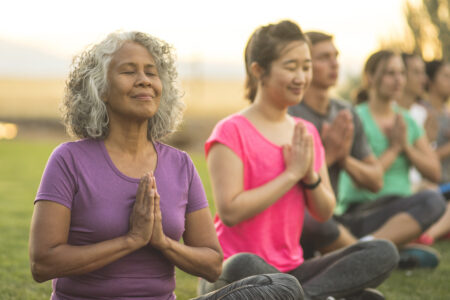 I felt that practicing meditation from that time helped me immensely when I began practicing Centering Prayer, which drew me closer to the Lord and through which I received many graces and favors for many years.
I felt that practicing meditation from that time helped me immensely when I began practicing Centering Prayer, which drew me closer to the Lord and through which I received many graces and favors for many years.
Unfortunately, I got "busy" with life, and haven't spent that quiet time with the Lord like I used to, and now I find it difficult to get to that quiet place with Him which was so beautiful.
I reject New Age ideas and can spot them when I see them. There is a Catholic Retreat Center near me with Sisters who sometimes offer New Age type programs. I won't go there.
Recently, I was thinking of doing some of the Yoga exercises at home again so I was surprised to read what you had to say about it. My intent is and always has been to worship the Lord in what I do and never, God forbid, worship some false deity, which would be totally against my will!
I would like to know your thoughts about this.
Pax et Bonum,
E.M.
TIA responds:
Dear E.M.,
We are pleased to hear that you are desirous to worship God correctly and that you reject the New Age spirituality.
It is important to remember that as Catholics, we must judge all spiritual exercises and meditations through the mind of the Church. We have to be willing to separate our personal experiences and feelings from things that are objectively wrong according to Catholic doctrine.
A Catholic has his sentiments ruled by his reason
A first consideration to take into account is something called discernment of spirits. A Catholic must be careful about letting his feelings and emotions regulate his spiritual life for he can easily be deceived by them.
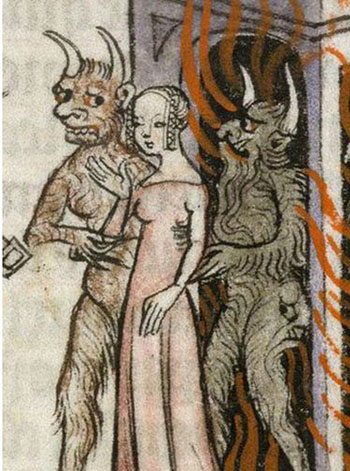 Traditionally, the Church has always advised that her children practice discernment. Fr. Peter Arnoudt give this description of the types of spirits: “Whence it appears, that in man there is a triple kind of thoughts and emotions; the first, springing from the free will of man himself; the second, thrown in from without by the demon, the evil spirit; the third, also suggested from without, but by the good Spirit.” (The Imitation of the Sacred Heart of Jesus. Silver City: 2011, p 39)
Traditionally, the Church has always advised that her children practice discernment. Fr. Peter Arnoudt give this description of the types of spirits: “Whence it appears, that in man there is a triple kind of thoughts and emotions; the first, springing from the free will of man himself; the second, thrown in from without by the demon, the evil spirit; the third, also suggested from without, but by the good Spirit.” (The Imitation of the Sacred Heart of Jesus. Silver City: 2011, p 39)
For, the Church teaches that the Devil can easily deceive those who rely on their own feelings. He can even appear as Our Lady, Our Lord and the Saints, and he can also give a certain degree of consolation when he wishes to deceive a person.
Simply because something makes a person feel good, or feel that he loves God, does not necessarily mean that it is good or comes from God. A pure love of God occurs when the person is entirely detached from the world, from self and from spiritual consolations. A pure love of God means following the Church in all things, even should this mean abandoning personal opinions or spiritual experiences.
An example of this is found in the life of St. Bernadette, who submitted to the judgment of the Church on the truth of the apparitions of Our Lady at Lourdes. The Church Prelates who questioned her were very cautious because they needed to be sure that the apparition was truly from Heaven.
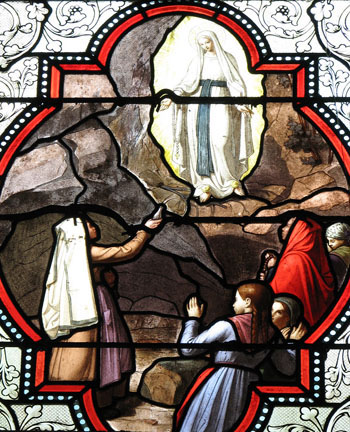 Bernadette displayed an admirable humility and detachment from the apparitions while she was being questioned, even going so far as to obey her mother’s request to sprinkle holy water on Our Lady to be sure that the apparition was not from the Devil.
Bernadette displayed an admirable humility and detachment from the apparitions while she was being questioned, even going so far as to obey her mother’s request to sprinkle holy water on Our Lady to be sure that the apparition was not from the Devil.
This being said, sometimes God gives graces and favors even when a person practices wrong things. So, it may be that God gave you graces when you practiced Yoga. This does not mean that those practices were good. The paradigmatic case is when a person is worshipping the Devil and receives graces to convert, as it hapens with the Belgian writer Joris-Karl Huysmans, who received graces of conversion while participating in a Black Mass.
Following these principles, Yoga must be analyzed to determine if it is in accordance with the Catholic Faith. We suggest you to carefully read the articles about Yoga on our website: here, here, here, here, here, here, here, here, here, here, and here.
In these articles you will find evidence that Yoga is bad and we hope you will be convinced to abandon its practice. It will be a good test to see if you, using reason instead of sentiment, are able to separate yourself from your past experiences.
Still, we offer one more observation on the Yoga positions to try convince you that they are not agreeable to God.
Yoga poses are immodest
Modesty is a Catholic virtue much neglected and scorned today by both women and men. As faithful Catholics, we should strive to practice modesty to respect our dignity as members of Christ’s Mystical Body and to give good example for others. Modesty, however, does not merely consist in wearing clothing that covers the body.
St. Ambrose of Milan explains that “modesty must further be guarded in our very movements and gestures and gait. For the condition of the mind is often seen in the attitude of the body. … Thus the movement of the body is a sort of voice of the soul.” St. Augustine confirms this truth: “In all your movements, let nothing be evident that would offend the eyes of another.”
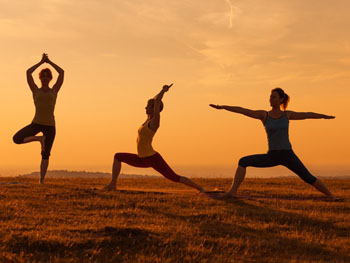
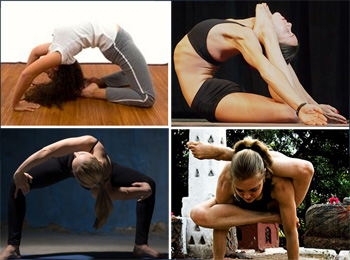 Do Yoga poses offend the eyes of others? The answer to this question is clearly affirmative if you consider the scandal that could be caused if you were
to be seen in a Yoga position in public. Further, because you mentioned that you used Yoga as a time for prayer, consider taking those positions in a church before the Blessed Sacrament. This would not be a respectful posture for being in the presence of God.
Do Yoga poses offend the eyes of others? The answer to this question is clearly affirmative if you consider the scandal that could be caused if you were
to be seen in a Yoga position in public. Further, because you mentioned that you used Yoga as a time for prayer, consider taking those positions in a church before the Blessed Sacrament. This would not be a respectful posture for being in the presence of God.
Our Lord is the King of the Universe and therefore deserves the greatest respect, even greater than we would show to an earthly king. Would you appear before an earthly king in a Yoga pose? Certainly not. You would appear as presentable as possible, dressed well and displaying poise and decorum. Likewise, when we present ourselves before God, we should take attitudes of the highest respect and modesty.
Even if prayer were not involved, the Yoga positions are not modest. At best, they draw attention to parts of the body that should remain covered. At worst, they distort the body into convoluted positions – similar to the positions taken by those who are demonically possessed.
The Yoga positions reveal rather than conceal the human form; therefore, they are not modest and, consequently, are not pleasing to God.
Centering prayer
Another important consideration is that the “Centering Prayer” to which you referred is not a Catholic form of meditation. The idea of Centering Prayer was developed by the Trappist Abbot Thomas Keating, who introduced Eastern religious philosophies, such as Buddhism and Hinduism, into his monastery.
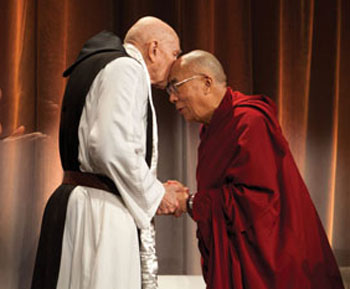 Keating created a new prayer method that comes from these false religions. The end goal of Centering Prayer is to empty the mind of all thoughts and imagining oneself to become one with God and the universe, which is a pagan practice (e.g. the Buddhist ‘Doctrine of Emptiness known as Sanskrit’).
Keating created a new prayer method that comes from these false religions. The end goal of Centering Prayer is to empty the mind of all thoughts and imagining oneself to become one with God and the universe, which is a pagan practice (e.g. the Buddhist ‘Doctrine of Emptiness known as Sanskrit’).
We recommend reading these four articles [here, here, here, and here] that better explain the problems with Centering Prayer.
The manner in which we pray is just as important as the words that we say. As the Church teaches: Lex orandi, lex credendi (the law of prayer is the law of faith or, how a person prays shapes what he believes). If the way in which a person prays follows methods used by the New Age, his beliefs will become those of New Age philosophies, even if this was not his original intention.
We recommend using the traditional Catholic method of meditation in order to have a "quiet time” with Our Lord. This method involves taking a respectful posture, kneeling or sitting erect. The meditation can last anywhere from 10 minutes to an hour, though the shorter time frame is always recommended for beginners.
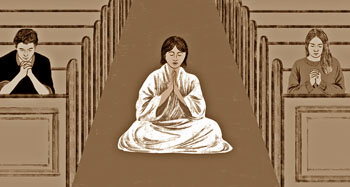 To begin, the Catholic fervently asks God to bless his meditation and direct his thoughts and desires. Then, there are several methods that may be used.
To begin, the Catholic fervently asks God to bless his meditation and direct his thoughts and desires. Then, there are several methods that may be used.
The Catholic may meditate on a mystery of the Rosary, on the Crucifix, on Holy Scriptures, or on some other spiritual book (such as The Imitation of Christ). He can think about a truth of the Faith. Or, he can picture Our Lord or Our Lady during a specific event in their lives and ponder the scene.
The end goal is to know God better and to love Him more. Most importantly, at the end of the meditation, a Catholic should make resolutions to become better, for the meditation is to help him to try to achieve what He expects from us.
In conclusion, we advise you to abandon Yoga and “Centering Prayer” and begin to set time apart in your day for true Catholic meditation and prayer. The Rosary, with its 15 mysteries, a perfect method of meditation on Christ’s life – is the best means for combating any New Age ideas that may still linger in your mind from your previous experiences.

In the 1980's I practiced Yoga exercises. I have always loved the Lord and agreed that God is God – not me, although I pray to be more like Jesus by His grace. I didn't get into the Eastern ideas and mainly liked the gentle stretch exercises and meditation (which were always general – imagining a peaceful scene and things like that). Sometimes I would play soft Christian music when I practiced at home, and used some of the poses to worship Jesus.

A ‘Catholic’ Yoga group meets to ‘meditate’
Unfortunately, I got "busy" with life, and haven't spent that quiet time with the Lord like I used to, and now I find it difficult to get to that quiet place with Him which was so beautiful.
I reject New Age ideas and can spot them when I see them. There is a Catholic Retreat Center near me with Sisters who sometimes offer New Age type programs. I won't go there.
Recently, I was thinking of doing some of the Yoga exercises at home again so I was surprised to read what you had to say about it. My intent is and always has been to worship the Lord in what I do and never, God forbid, worship some false deity, which would be totally against my will!
I would like to know your thoughts about this.
Pax et Bonum,
E.M.
______________________
TIA responds:
Dear E.M.,
We are pleased to hear that you are desirous to worship God correctly and that you reject the New Age spirituality.
It is important to remember that as Catholics, we must judge all spiritual exercises and meditations through the mind of the Church. We have to be willing to separate our personal experiences and feelings from things that are objectively wrong according to Catholic doctrine.
A Catholic has his sentiments ruled by his reason
A first consideration to take into account is something called discernment of spirits. A Catholic must be careful about letting his feelings and emotions regulate his spiritual life for he can easily be deceived by them.

The Devil can fool a person into thinking
his ‘experience’ is good
For, the Church teaches that the Devil can easily deceive those who rely on their own feelings. He can even appear as Our Lady, Our Lord and the Saints, and he can also give a certain degree of consolation when he wishes to deceive a person.
Simply because something makes a person feel good, or feel that he loves God, does not necessarily mean that it is good or comes from God. A pure love of God occurs when the person is entirely detached from the world, from self and from spiritual consolations. A pure love of God means following the Church in all things, even should this mean abandoning personal opinions or spiritual experiences.
An example of this is found in the life of St. Bernadette, who submitted to the judgment of the Church on the truth of the apparitions of Our Lady at Lourdes. The Church Prelates who questioned her were very cautious because they needed to be sure that the apparition was truly from Heaven.

St. Bernadette sprinkling holy water at Our Lady
This being said, sometimes God gives graces and favors even when a person practices wrong things. So, it may be that God gave you graces when you practiced Yoga. This does not mean that those practices were good. The paradigmatic case is when a person is worshipping the Devil and receives graces to convert, as it hapens with the Belgian writer Joris-Karl Huysmans, who received graces of conversion while participating in a Black Mass.
Following these principles, Yoga must be analyzed to determine if it is in accordance with the Catholic Faith. We suggest you to carefully read the articles about Yoga on our website: here, here, here, here, here, here, here, here, here, here, and here.
In these articles you will find evidence that Yoga is bad and we hope you will be convinced to abandon its practice. It will be a good test to see if you, using reason instead of sentiment, are able to separate yourself from your past experiences.
Still, we offer one more observation on the Yoga positions to try convince you that they are not agreeable to God.
Yoga poses are immodest
Modesty is a Catholic virtue much neglected and scorned today by both women and men. As faithful Catholics, we should strive to practice modesty to respect our dignity as members of Christ’s Mystical Body and to give good example for others. Modesty, however, does not merely consist in wearing clothing that covers the body.
St. Ambrose of Milan explains that “modesty must further be guarded in our very movements and gestures and gait. For the condition of the mind is often seen in the attitude of the body. … Thus the movement of the body is a sort of voice of the soul.” St. Augustine confirms this truth: “In all your movements, let nothing be evident that would offend the eyes of another.”

Many immodest clothing & poses...
...similar to possessed persons, below

Our Lord is the King of the Universe and therefore deserves the greatest respect, even greater than we would show to an earthly king. Would you appear before an earthly king in a Yoga pose? Certainly not. You would appear as presentable as possible, dressed well and displaying poise and decorum. Likewise, when we present ourselves before God, we should take attitudes of the highest respect and modesty.
Even if prayer were not involved, the Yoga positions are not modest. At best, they draw attention to parts of the body that should remain covered. At worst, they distort the body into convoluted positions – similar to the positions taken by those who are demonically possessed.
The Yoga positions reveal rather than conceal the human form; therefore, they are not modest and, consequently, are not pleasing to God.
Centering prayer
Another important consideration is that the “Centering Prayer” to which you referred is not a Catholic form of meditation. The idea of Centering Prayer was developed by the Trappist Abbot Thomas Keating, who introduced Eastern religious philosophies, such as Buddhism and Hinduism, into his monastery.

Keating kisses his master Dala Lama
We recommend reading these four articles [here, here, here, and here] that better explain the problems with Centering Prayer.
The manner in which we pray is just as important as the words that we say. As the Church teaches: Lex orandi, lex credendi (the law of prayer is the law of faith or, how a person prays shapes what he believes). If the way in which a person prays follows methods used by the New Age, his beliefs will become those of New Age philosophies, even if this was not his original intention.
We recommend using the traditional Catholic method of meditation in order to have a "quiet time” with Our Lord. This method involves taking a respectful posture, kneeling or sitting erect. The meditation can last anywhere from 10 minutes to an hour, though the shorter time frame is always recommended for beginners.

Do not follow the pagan models of prayer or posture
The Catholic may meditate on a mystery of the Rosary, on the Crucifix, on Holy Scriptures, or on some other spiritual book (such as The Imitation of Christ). He can think about a truth of the Faith. Or, he can picture Our Lord or Our Lady during a specific event in their lives and ponder the scene.
The end goal is to know God better and to love Him more. Most importantly, at the end of the meditation, a Catholic should make resolutions to become better, for the meditation is to help him to try to achieve what He expects from us.
In conclusion, we advise you to abandon Yoga and “Centering Prayer” and begin to set time apart in your day for true Catholic meditation and prayer. The Rosary, with its 15 mysteries, a perfect method of meditation on Christ’s life – is the best means for combating any New Age ideas that may still linger in your mind from your previous experiences.

Posted November 14, 2022
______________________
______________________
 Volume I |
 Volume II |
 Volume III |
 Volume IV |
 Volume V |
 Volume VI |
 Volume VII |
 Volume VIII |
 Volume IX |
 Volume X |
 Volume XI |
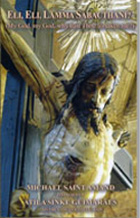 Special Edition |


